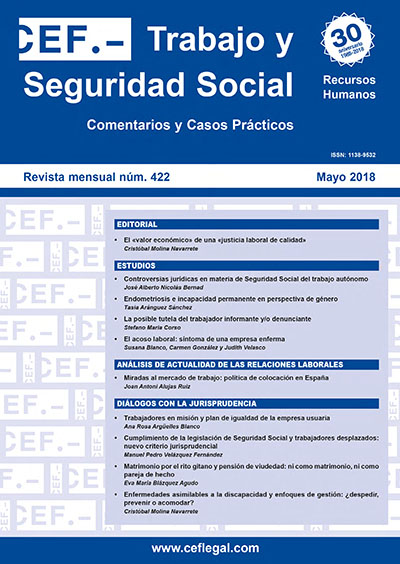Endometriosis and occupational disability in gender perspective
DOI:
https://doi.org/10.51302/rtss.2018.1610Keywords:
occupational disability, endometriosis, gender, fibromyalgiaAbstract
The objects on this study are the resolutions on occupational disability in women with endometriosis. We argue, with other authors, that there seems to be gender troubles in the total and absolute permanent disability resolutions for endometriosis and other diseases of high female prevalence. We present a description of endometriosis, as a permanent disease, with objective character, and of the classifications that allow determining its severity and the functional limitations that it produces. From an analysis of 65 sentences, we expose the fundamental problems of permanent disability due to endometriosis and the courts criteria that currently determine the total and absolute permanent disability declaration, respectively. We conclude that endometriosis is almost always invisible in jurisprudence, so it is mentioned in the clinical description (between other diseases) but is not mentioned in the basis of the resolution and is attributed less importance to endometriosis in relation to other diseases (including other feminized diseases, in which less relative importance is also perceived).
Downloads
References
AETS (2017). Endometriosis. Revisión de la evidencia científica. Madrid: Agencia de Evaluación de Tecnologías Sanitarias (AETS). Instituto de Salud Carlos III. Recuperado de http://www.msssi.gob.es/organizacion/sns/planCalidadSNS/pdf/equidad/informeEvidenciaEndometriosis70308.pdf (consultado el 6 de enero de 2018).
Ashton, H. (1991). Psychotropic-drug prescribing for women. The British Journal of Psychiatry, 158(10), 30-35.
Bernstein, B. y Kane, R. (1981). «Physicians» attitudes toward female patients. Med Care, 19(6), 600-8.
Brouwer, R. y Woods, R. J. (2007). Rectal endometriosis: results of radical excision and review of published work. ANZ J. Surg, 77(7), 562-571.
Carmona, F., Martínez-Zamora, A., González, X., Ginés, A., Buñesch, L. y Balasch, J. (2009). Does the learning curve of conservative laparoscopic surgery in women with rectovaginal endometriosis impair the recurrence rate? Fertility and Sterility, 92(3), 868-875.
César Carvajal, A. (2013). Aspectos psicopatológicos del dolor pelviano crónico: abordaje clínico. Revista Médica Clínica Las Condes, 24(2), 270-276. Recuperado de https://www.sciencedirect.com/science/article/pii/S0716864013701585#! (consultado el 6 de enero de 2018).
Colameco, S., Becker, L. A. y Simpson, M. (1983). Sex bias in the assessment of patients complaints. J-Fam-Pract, 16, 1.117-1.121.
Davis, L., Kennedy, SS., Moore, J. y Prentice, A. (2007). Modern combined oral contraceptives for pain associated with endometriosis. Cochrane Database of Systematic Reviews, 3.
Ding, S., Zhu, L., Tian, Y., Zhu, T., Huang, X. y Zhang, X. (2017). P2X3 receptor involvement in endometriosis pain via ERK signaling pathway. PLoS ONE, 12(9).
Edlow, A. G. y Laufer, M. R. (2012). La endometriosis en los adolescentes. En J. A. García-Velasco y B. RMB Rizk, Endometriosis: tratamiento actual y futuras tendencias. Panamá: Jaypee-Highlights. Recuperado de https://s887fc1a476f4682b.jimcontent.com/download/version/1435684430/module/6697004254/name/endometriosis_tratamiento_actual_y_futuras_tendencias_rinconmedico.net.pdf (consultado el 6 de enero de 2018).
Guía SAS. (2009). Guía de atención a mujeres con endometriosis en el sistema sanitario público de Andalucía. Sevilla: Junta de Andalucía. Consejería de Salud. Servicio Andaluz de Salud. Recuperado de http://www.juntadeandalucia.es/servicioandaluzdesalud/contenidos/publicaciones/datos/315/pdf/GUIA13abril09.pdf (consultado el 6 de enero de 2018).
Guía SNS. (2013). Guía de atención a las mujeres con endometriosis en el Sistema Nacional de Salud (SNS). Madrid: Ministerio de Sanidad, Servicios Sociales e Igualdad. Recuperado de http://www.msc.es/organizacion/sns/planCalidadSNS/pdf/equidad/ENDOMETRIOSIS.pdf (consultado el 6 de enero de 2018).
Guo, SW. (2009). Recurrence of endometriosis and its control. Hum Reprod Update, 15(4), 441-461.
Hohmann, A. (1989). Gender Bias in Psychotropic Drug Prescribing in Primary Care. Medical Care.
Hummelshoj, L. (2004). Meeting expectations in the chronically ill patient by extending the therapeutic network. In Z. Ben-Rafael, R. Lobo and Z. Shoham (Eds.), Proceedings from the 5th World Congress on Controversies in Obstetrics, Gynecology and Infertility.
Kennedy, S., Bergqvist, A., Chapron, C., D´Hooghe, T., Dunselman, G., Greb, R., Hummelshoj, L., Prentice, A. y Saridogan, E. (2005). ESHRE guideline for the diagnosis and treatment of endometriosis. Hum Reprod, 20, 2.698-2.704.
Koninckx, P. R., Meuleman, C., Demeyere, S., Lesaffre, E. y Cornillie, F. J. (2006). Suggestive evidence that pelvic endometriosis is a progressive disease, whereas deeply infiltrating endometriosis is associated with pelvic pain. Fertil Steril, 55, 759-765.
López Carrillo, M. (s. f.). La medicalización de la vida y la salud de las mujeres. Revista Mujeres y Salud. Recuperado de http://www.caps.cat/images/stories/Medicalizacion_de_la_vida_y_la_salud_Xarxa_de_salut_Margarita_Lopez_Carrillo.pdf (consultado el 6 de enero de 2018).
Lousada Arochena, J. F. (2010). El tratamiento jurídico de la fibromialgia en perspectiva de género. Aequalitas: Revista jurídica de igualdad de oportunidades entre mujeres y hombres, 26, 30-37.
Matorras, R. y Cobos, P. (2010). Epidemiology of endometriosis. In J. A. García-Velasco and Rizk MRB (Eds.), Endometriosis Current Management and Future Trends (pp. 10-8). New Delhi: Jaypee Brothers Medical Publishers.
Rivas Vallejo, P. (2009). Aspectos jurídicos en la incapacidad y discapacidad en el síndrome de fatiga crónica. En T. Fernández de Sevilla Ribosa (Dir.), VII Jornada sobre Avances en el Síndrome de Fatiga Crónica. Recuperado de http://laff.es/pdf/SFCRIVAS1.pdf (consultado el 6 de enero de 2018).
Rogers, P. A. W., D’Hooghe, T. M., Fazleabas, A., Gargett, C. E., Giudice, L. C., Montgomery, G. W., ... y Zondervan, K. T. (2009). Priorities for endometriosis research: Recommendations from an international consensus workshop. Reproductive Sciences, 16(4), 335-346.
Royal College of Obstetricians and Gynecologists. (2006). The investigation and management of endometriosis. RCOG Gideline, 24, 1-14.
Selak, V., Farquhar, C., Prentice, A. y Singla, A. A. (2007). Danazol for pelvic pain associated with endometriosis. Cochrane Database of Systematic Reviews, 4.
Valls-Llobet, C. (2001). Desigualdades de género en salud pública. Quadern CAPS, 30.
Valls-Llobet, C. (2006). Mujeres invisibles. Barcelona: Debolsillo.


















